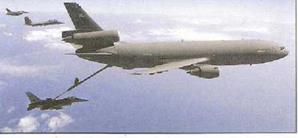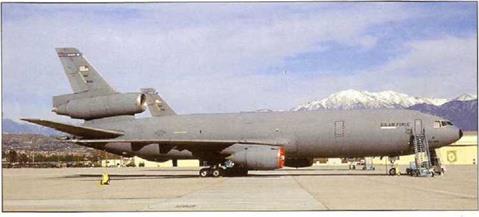McDonnell Douglas KC-10 Extender
|
|
T |
he McDonnell Douglas KC-10A Extender strategic tanker/transport is based or tne DC-10 Series 3QCF commercial fre ghter/airliner and was developed to satisfy the USAF’s ATCA (Advancec Tanker Cargo Aircraft) requirement. An in tial oatch of 16 aircraft was first ordered in 1977 and procurement was later increased to 60 aircaft. The first Extender made its maiden flight on 12 July 1980 and deliveries to SAC took place between March 1981’and November 1988.
Changes from the commercial DC-10 standard include provision of an IFR receptacle above the cockpit, an improved cargo handling system and some military avionics. A McDonnell Douglas Advanced Aerial Refuelling Boom (AARB) is fitted beneath the aft fuselage. The digital FBW control boom can transfer fuel at a rate of 5678 litres (1,249 Imp gal) per minute. The KC-10 is also fitted with a hose and reel unit :n the starboard aft fuselage and can thus refuel Navy and USMC aircraft during the same mission. This is a unique capability and one that makes it much more versatile than the KC-135. More recently, wing-mounted HDU pods have been fitted to all KC-10s so that three receiver aircraft may be refuelled simultaneously with this very capable system.
The KC-10’s substantial fuei-off/oad and cargocarrying ability makes it well suited to supporting fighter deployments over long distances.
The wring ano fuselage fuel cells contain approxr mate y 68610 itres (15,092 Imp gal) and are nter – connected with tne aircraft’s own basic fuel system. The KC-10 is aole to transfer 90/18 kg (200,000 lb) of fuel to a receiver 3540 km (2,200 miles) from its home base and return to base. For conventional strategic transport missions the KC-10 has a port-side cargo door and carries standard USAF pallets, bulk cargo or wheeled vehicles. Dual tanker/transport missions include accompanying deploying fighters.
Two ex-Martinair DC-10-30CFs were procured by the Netherlands for conversion by McDonnell Douglas to tanker configuration, and entered service with the KLU in 1995 as the KDC-10. Unlike the KC-10 refuelling operator who guides the refuelling through an optical window, the KDC-10 ‘Boomer’ uses a Three camera TV system to give a ‘three dimensional’ view. The Dutch tankers have been used to support F-16 deployments to Red Flag’ and other exercises in the US
the USAF now has a fleet of 59 KC-10s after one was destroyed in an accident on the ground. All active aircraft are operated by Air Mobility Command, based principally at McGuire AFR (305th AMW) and Travis AFB (60th AMW).

|












